Navajo Boy and Girl with Fawns by Harrison Begay - C3788G
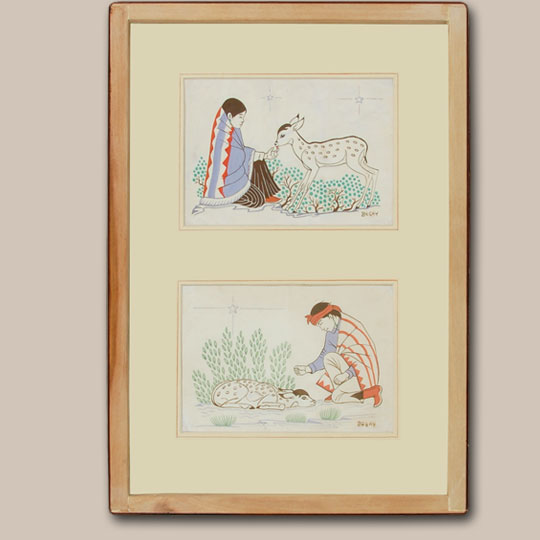 Navajo painter Harrison Begay (1914-2012) was one of the most well-known students of the Santa Fe Indian School, where he was educated from 1934 to 1940. He received a great deal of international acclaim during his long career, and was one of the first Native American artists to support himself financially with his artwork. Begay enjoyed a long career as a prolific creator of "flat-style" watercolor paintings, celebrating beauty and serenity with a warm and inviting color palette.
Navajo painter Harrison Begay (1914-2012) was one of the most well-known students of the Santa Fe Indian School, where he was educated from 1934 to 1940. He received a great deal of international acclaim during his long career, and was one of the first Native American artists to support himself financially with his artwork. Begay enjoyed a long career as a prolific creator of "flat-style" watercolor paintings, celebrating beauty and serenity with a warm and inviting color palette.
With the intent to share Navajo and Pueblo paintings with a wider audience, Begay and printer Charles Barrows started a silkscreen business called Tewa Enterprises. Tewa reproduced Begay's work and that of many of his contemporaries, including Gerald Nailor and J.D. Roybal. Begay was uniquely qualified to enter the printing business, and was able to sell high-quality prints at reasonable prices. Tewa's prints are still readily available from a variety of sources, and are desirable because of their connection to the artist himself.
Hopi Pueblo Monongya - Lizard Katsina Doll - C3805C
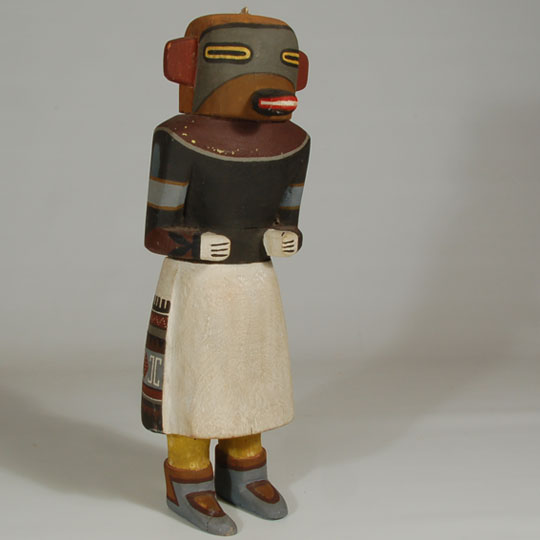 "The Lizard Kachina is one of the Fighting Kachinas, a group that furnishes individuals to chastise the clowns for their un-Hopi behavior. He is presumed to represent a particular species of Lizard, the Crotophytus. This particular lizard is a brilliant turquoise color and very fast in movement." Wright 1973
"The Lizard Kachina is one of the Fighting Kachinas, a group that furnishes individuals to chastise the clowns for their un-Hopi behavior. He is presumed to represent a particular species of Lizard, the Crotophytus. This particular lizard is a brilliant turquoise color and very fast in movement." Wright 1973
Based on carving style and paint, this appears to be from the 1940s. It is simple in detail and quite plain in appearance which is a true representation of this Katsina when it appears in the Mixed Katsina Dance or Powamu. A spread of feathers that is supposed to be on the back of the head has been removed, as have the feathers on top of the head. This is probably the truest representation of this Katsina as it should appear.
Hopi Pueblo Na-ngasohu Katsina Doll - C3805A
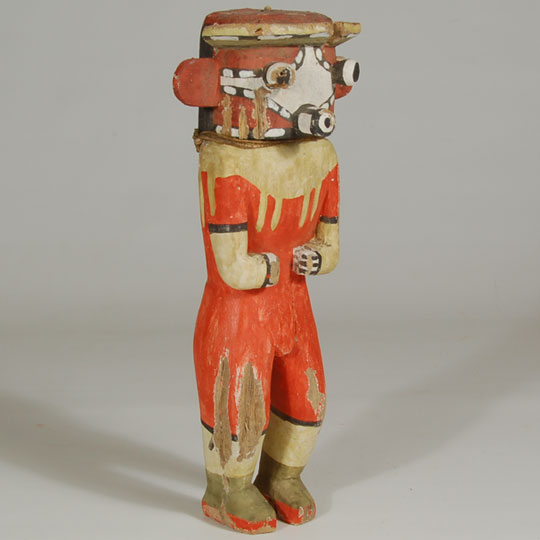 The Hopi Na-ngasohu Katsina seems to have several English translations-Planet, Meteor, and Chasing Star-and each publication shows the same Katsina regardless of the name under which it is described. Physically it is a handsome Katsina with an enormous fan of eagle feathers behind the head and back. It has a simple four pointed star for a face with no visible eyes or mouth.
The Hopi Na-ngasohu Katsina seems to have several English translations-Planet, Meteor, and Chasing Star-and each publication shows the same Katsina regardless of the name under which it is described. Physically it is a handsome Katsina with an enormous fan of eagle feathers behind the head and back. It has a simple four pointed star for a face with no visible eyes or mouth.
This Katsina doll was sold to the current owner as Na-ngasohu but it does not resemble in any manner the published version of that Katsina. It was listed as a circa 1890s carving. Perhaps there is an older version that differs from today's version of this Katsina but I have not found a picture of one yet. Perhaps it is a different Katsina which I have not yet discovered in a publication.
Hopi Yehoho or Tsekok-yenu - Roast Corn Throwing Boy Katsina Doll - C3805B
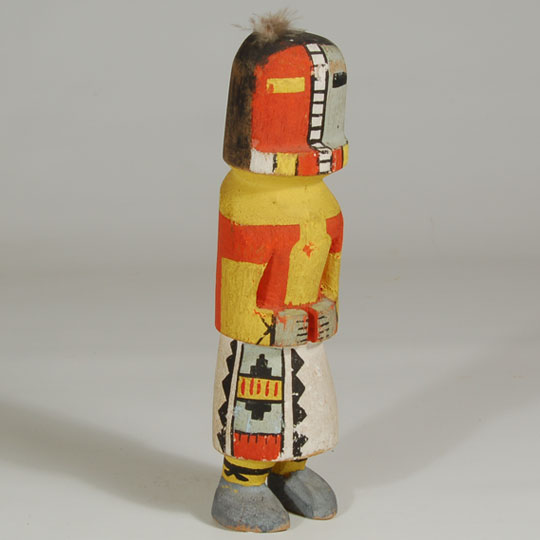 The Roast Corn Throwing Boy Katsina is another of the many plant Katsinas and as such is a prayer for the growth, propagation and successful harvesting of corn. His costume is made of bobcat skin and is reminiscent of those from the Eastern/Tewa pueblos. Like other corn Katsinam, he wears horizontally crossed feathers on the top of his head pointing in four directions. While he may appear with the mixed Katsinas or the runners, on occasion a group of these Katsinas will appear in the evening to dance and throw baked corn to the spectators. His name Yehoho comes from the sound which he makes.
The Roast Corn Throwing Boy Katsina is another of the many plant Katsinas and as such is a prayer for the growth, propagation and successful harvesting of corn. His costume is made of bobcat skin and is reminiscent of those from the Eastern/Tewa pueblos. Like other corn Katsinam, he wears horizontally crossed feathers on the top of his head pointing in four directions. While he may appear with the mixed Katsinas or the runners, on occasion a group of these Katsinas will appear in the evening to dance and throw baked corn to the spectators. His name Yehoho comes from the sound which he makes.
Cochiti Pueblo 10-piece Pottery Nacimiento Set by Seferina Ortiz - C3804C
 Seferina Ortiz was one of the most respected potters at Cochiti. She specialized in making figurines-storytellers, nacimientos, and animal and human figures. A collection of 32 items of pottery by Seferina is in the Peabody Museum of Harvard University. She is considered one of the matriarchs of the potter population of Cochiti Pueblo. Not only did she leave a legacy of her pottery, she left a legacy in her children-Joyce, Janice, Inez, Virgil, Leon and Angie, some of whom are considered top potters today.
Seferina Ortiz was one of the most respected potters at Cochiti. She specialized in making figurines-storytellers, nacimientos, and animal and human figures. A collection of 32 items of pottery by Seferina is in the Peabody Museum of Harvard University. She is considered one of the matriarchs of the potter population of Cochiti Pueblo. Not only did she leave a legacy of her pottery, she left a legacy in her children-Joyce, Janice, Inez, Virgil, Leon and Angie, some of whom are considered top potters today.
Hopi Pueblo Kwivi - Proud Katsina Doll - C3805D
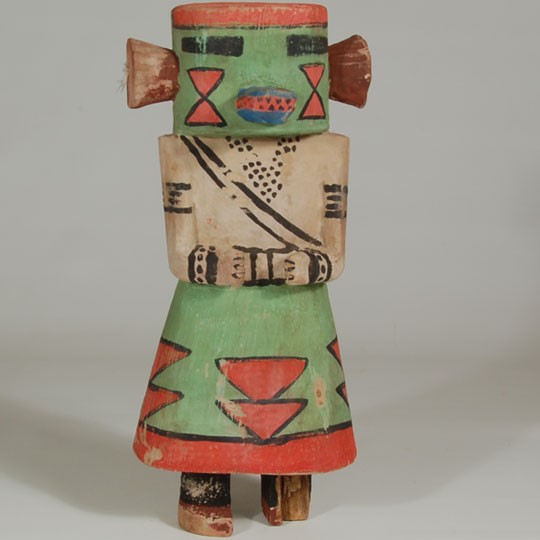 The Kwivi katsina is a Hopi Katsina that honors and depicts the Hopi's Navajo neighbors. It is not borrowed from the Navajo but is Pueblo in every sense because the Katsina are unique to the Pueblo Indians. He serves the same functions and carries the same responsibilities as any other Katsina. His name means showy and is derived from the flashy dress and decorations. He is listed as circa 1920-30.
The Kwivi katsina is a Hopi Katsina that honors and depicts the Hopi's Navajo neighbors. It is not borrowed from the Navajo but is Pueblo in every sense because the Katsina are unique to the Pueblo Indians. He serves the same functions and carries the same responsibilities as any other Katsina. His name means showy and is derived from the flashy dress and decorations. He is listed as circa 1920-30.
Penitente Carved Cedar Death Cart by Albert L. Martinez - C3799B
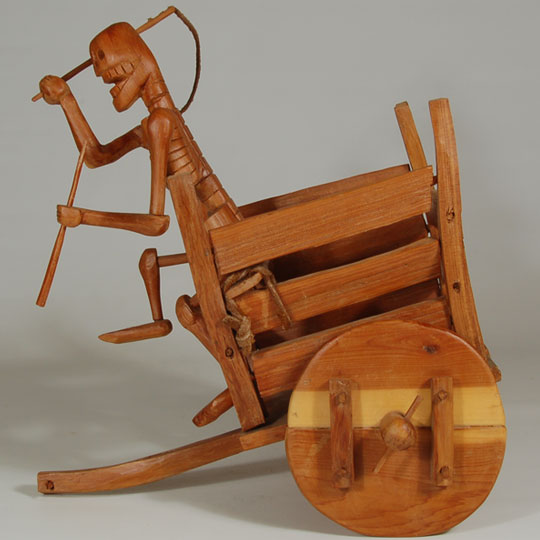 In the 17th Century, what is now known as New Mexico was considered to be the northern frontier of Mexico. Separated by extreme time and distance, this land was considered to be remote even by 17th Century standards. The church in Mexico basically ignored the northern frontier and as a result the local people developed their own way of celebrating the birth and death of Christ. A group that is referred to today as the Penitentes took over the task of caring for the spiritual needs of the villages of Nuevo Mexico.
In the 17th Century, what is now known as New Mexico was considered to be the northern frontier of Mexico. Separated by extreme time and distance, this land was considered to be remote even by 17th Century standards. The church in Mexico basically ignored the northern frontier and as a result the local people developed their own way of celebrating the birth and death of Christ. A group that is referred to today as the Penitentes took over the task of caring for the spiritual needs of the villages of Nuevo Mexico.
One important aspect of the many duties of the Penitentes was to celebrate the Passion of Christ during Holy Week. Death carts, with the figure of La Muerte, or Doña Sebastiana, appeared in processions during Holy Week. A member of the Penitente brotherhood would drag the heavy cart from the Morada, or meeting place, to the Calvario, or symbolic Calvary, atop a nearby hill. The carts represented the ever-looming specter of Death and reminded people of the miracle of Christ's triumph over death. It was also a reminder to the faithful that death is ever-present, and of the importance of leading a virtuous life in order to enter the kingdom of heaven.
Hopi Tewa Clown Puppet Katsina Doll by Jimmie Koots - 25871
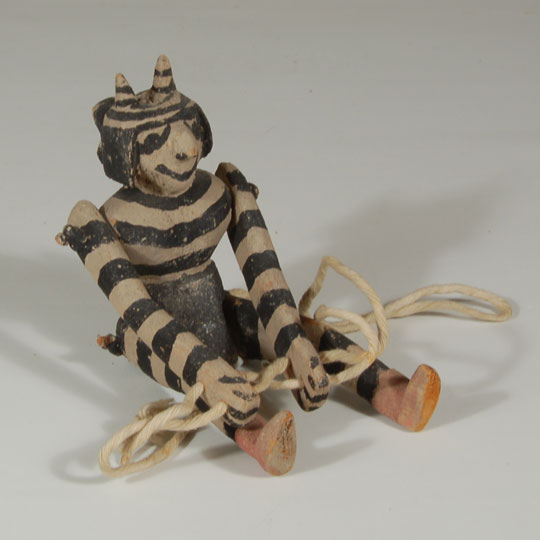 There is very little published information on Hopi puppets and the artists who create them. It has been stated that Jimmy Koots and Henry Seeni are the carvers who made them in the mid-20th century. Whether they were made for Hopi ceremonial or entertainment use or made solely for sale to tourists is not documented.
There is very little published information on Hopi puppets and the artists who create them. It has been stated that Jimmy Koots and Henry Seeni are the carvers who made them in the mid-20th century. Whether they were made for Hopi ceremonial or entertainment use or made solely for sale to tourists is not documented.
This one represents a Tewa Clown or Koshare. Although referred to as Katsina dolls, Koshare are technically not Katsinas. They are probably one of the best-known figures and the most frequently carved clowns at Hopi. Ironically, he is not of Hopi origin, but is of Tewa origin, and arrived with the Tewa immigrants from the New Mexico Rio Grande pueblos in the early 18th century.
Small Mongwa - Owl Katsina Doll by Koots by Jimmie Koots - 25872
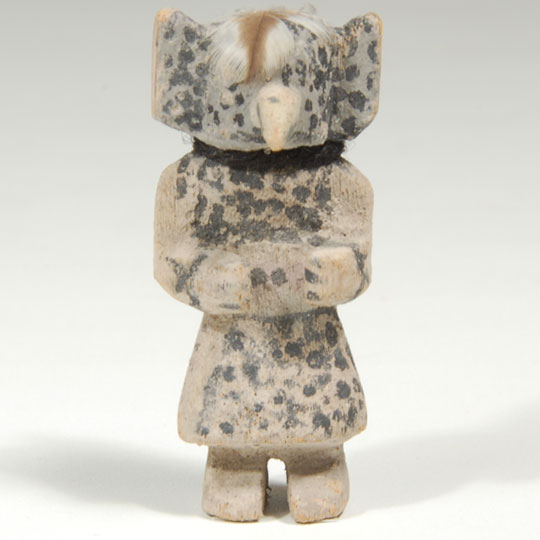 There are collectors of Southwest Indian items who concentrate on items of the smallest scale. Some do so because they set up displays of miniature items in crate-like boxes. Others collect miniatures for display in dollhouses, where every item has to be in proper scale.
There are collectors of Southwest Indian items who concentrate on items of the smallest scale. Some do so because they set up displays of miniature items in crate-like boxes. Others collect miniatures for display in dollhouses, where every item has to be in proper scale.
Whether that is the reason Jimmy Koots made such a small Owl Katsina doll is not known, but presented here is the smallest Koots katsina doll of which I am aware. It is barely 2 inches tall.
Small Mongwa Wuhti - Female Owl Katsina Doll by Jimmie Koots - 25873
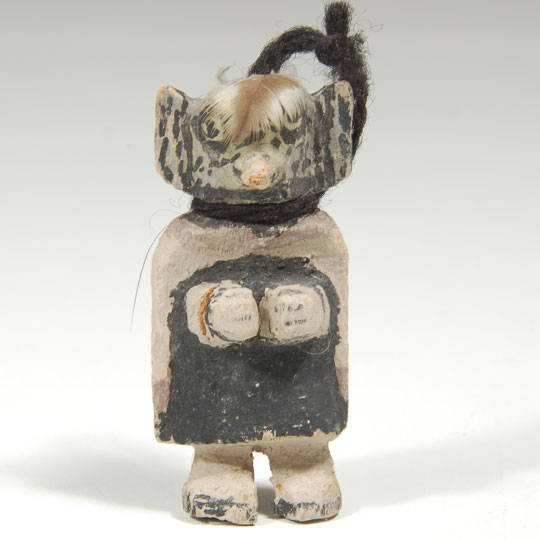 The Great Horned Owl Wuhti (female) has only been published in Fewkes' article on Hopi Katsinas and has appeared nowhere else. Present-day Hopi are not aware of the female version, so perhaps it has not been seen in over a hundred years.
The Great Horned Owl Wuhti (female) has only been published in Fewkes' article on Hopi Katsinas and has appeared nowhere else. Present-day Hopi are not aware of the female version, so perhaps it has not been seen in over a hundred years.
This version of the Mongwa Wuhti is beautifully carved and painted. She wears a traditional pueblo manta and has a white wedding shawl draped over her shoulders. She appears to be carved from a single piece of cottonwood root.
Historic Zuni Pueblo Large White-on-red Olla - C3776U
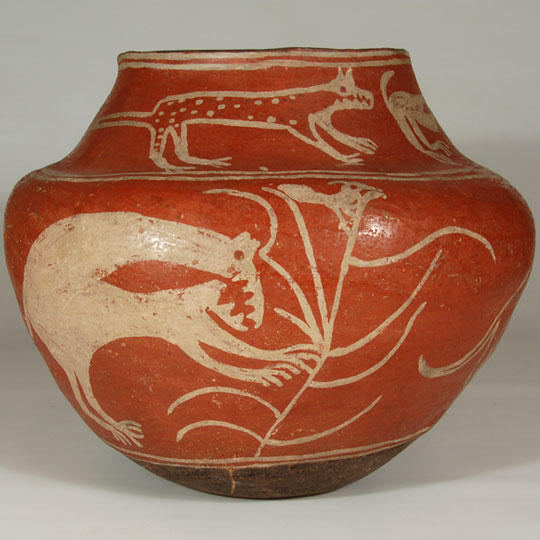 Starting as early as 1840, potters at Zuni Pueblo have been producing wares that have been classified as Zuni Polychrome. Now, 175 years later, they are still being made. During that time span, other styles have come and gone. Perhaps some potters or families tired of doing the same style and began experimenting with something new.
Starting as early as 1840, potters at Zuni Pueblo have been producing wares that have been classified as Zuni Polychrome. Now, 175 years later, they are still being made. During that time span, other styles have come and gone. Perhaps some potters or families tired of doing the same style and began experimenting with something new.
One of these short-lived experiments was pottery slipped in red and decorated in white. It apparently began around 1890 and ended in the 1920s, a short period of around 30 years. The new style could have been influenced by sherds from prehistoric St. Johns Polychrome from near the current Zuni Pueblo boundaries, or from prehistoric sherds being excavated at Hawikuh and Halona villages. Anthropologists could have shown sherds to potters or potters could have unearthed sherds themselves for use as temper. It is easy to see that these White-on-red wares of the late 1800s had a precedent at or near Zuni and were not a completely new innovation dreamed up by potters of the day.
Cochiti Pueblo Pottery 12-piece Nacimiento by Ada Cordero Suina - C3804B
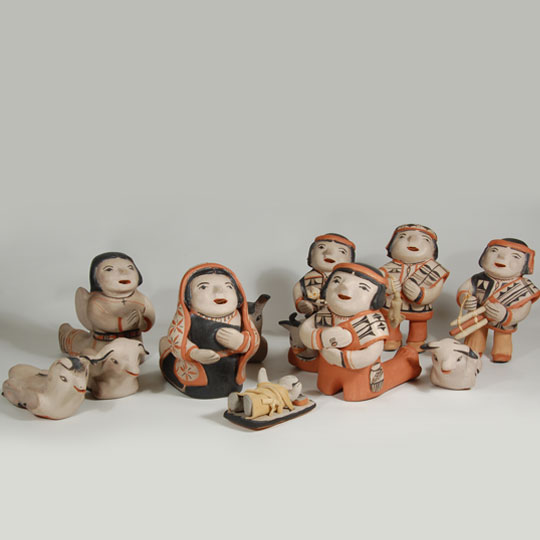 Ada Suina resumed making pottery figurines a few years ago after several years of not doing so following the death of her husband. She relied so much on his help in digging the clay and working it to a point where she could form the figurines. Now, at age 86, she has to do everything by herself, therefore it is taking significantly more time to complete a piece. She is not very actively making pottery at this time. She was not displaying pottery at the Santa Fe Indian Market in 2015.
Ada Suina resumed making pottery figurines a few years ago after several years of not doing so following the death of her husband. She relied so much on his help in digging the clay and working it to a point where she could form the figurines. Now, at age 86, she has to do everything by herself, therefore it is taking significantly more time to complete a piece. She is not very actively making pottery at this time. She was not displaying pottery at the Santa Fe Indian Market in 2015.
Diné - Navajo Sterling Silver Mother-in-law Bell Earrings - C3773Z
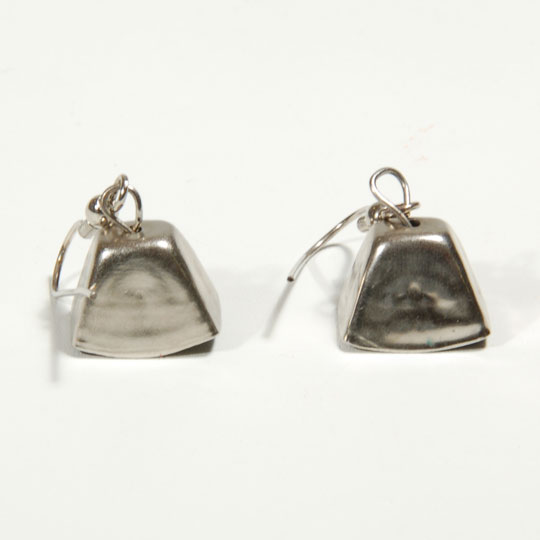 The Navajo "mother-in-law" bell is worn by the mother-in-law to warn her son-in-law of her impending arrival. The Navajo believe that the two must not lay eyes on each other. These charming "mother-in-law" bell earrings have a delightful ring to them. They are carefully fashioned to produce a delicate chime as the wearer moves.
The Navajo "mother-in-law" bell is worn by the mother-in-law to warn her son-in-law of her impending arrival. The Navajo believe that the two must not lay eyes on each other. These charming "mother-in-law" bell earrings have a delightful ring to them. They are carefully fashioned to produce a delicate chime as the wearer moves.
Hopi Pueblo Kokopelli Katsina Doll - C3805F
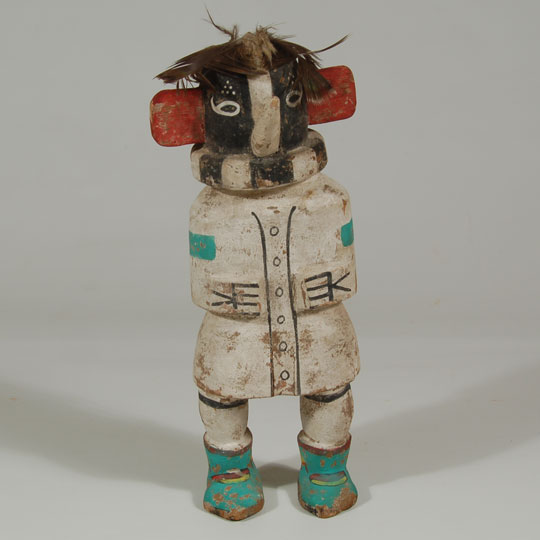 Kokopelli, the hump-backed Flute Player, has been notoriously denigrated in the Southwest with tourist-related items such as coasters, napkins, magnets, and other kinds of miscellaneous bric-a-brac. Some of the interest in him is because he is so blatantly phallic in appearance. In reality, however, he is a very important personage to the pueblo people. He appeared in Mimbres and Hohokam pottery decorations of a thousand years ago. He also is documented in petroglyph drawings and pictographs representations.
Kokopelli, the hump-backed Flute Player, has been notoriously denigrated in the Southwest with tourist-related items such as coasters, napkins, magnets, and other kinds of miscellaneous bric-a-brac. Some of the interest in him is because he is so blatantly phallic in appearance. In reality, however, he is a very important personage to the pueblo people. He appeared in Mimbres and Hohokam pottery decorations of a thousand years ago. He also is documented in petroglyph drawings and pictographs representations.
Small Hopi Pueblo Open Bowl by Nampeyo of Hano - C3801
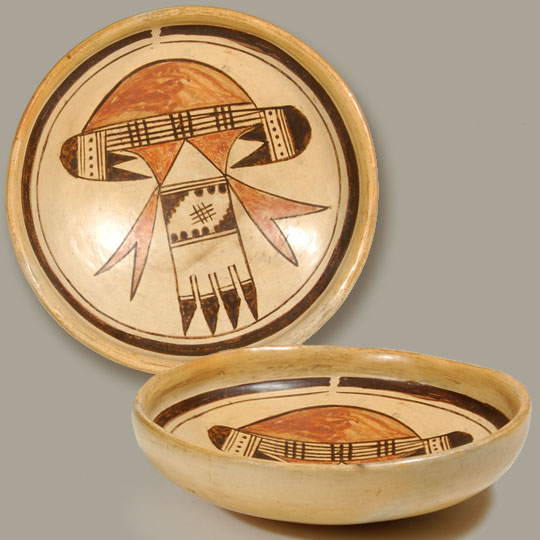 This exquisite small bowl is attributed to Nampeyo of Hano based on construction techniques, layout of design, and execution of design. One of the first items of consideration is the extra coil of clay Nampeyo placed at the rim of bowls which is quite obvious on this small bowl. The bottom is rounded, not flattened, and shows evidence of long polishing strokes as was typical of Nampeyo. The layout of the design is very typical of her style.
This exquisite small bowl is attributed to Nampeyo of Hano based on construction techniques, layout of design, and execution of design. One of the first items of consideration is the extra coil of clay Nampeyo placed at the rim of bowls which is quite obvious on this small bowl. The bottom is rounded, not flattened, and shows evidence of long polishing strokes as was typical of Nampeyo. The layout of the design is very typical of her style.
Zia Pueblo Set of Four Pottery Buttons - C3776Q
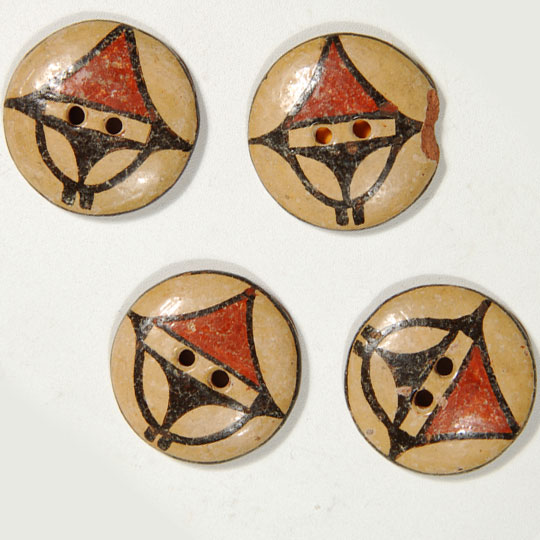 After the influenza epidemic that swept the area in the early 20th century, there were less than 200 people living at Zia Pueblo. Since the late 1800s, Zia women had been exchanging pottery with the nearby traders for food and other goods or money. This ability of Zia women to make fine pots for trade made it possible for the pueblo to survive the hard times.
After the influenza epidemic that swept the area in the early 20th century, there were less than 200 people living at Zia Pueblo. Since the late 1800s, Zia women had been exchanging pottery with the nearby traders for food and other goods or money. This ability of Zia women to make fine pots for trade made it possible for the pueblo to survive the hard times.
Hopi Large Polished Red Wedding Vessel by Garnet Pavatea - C3803A
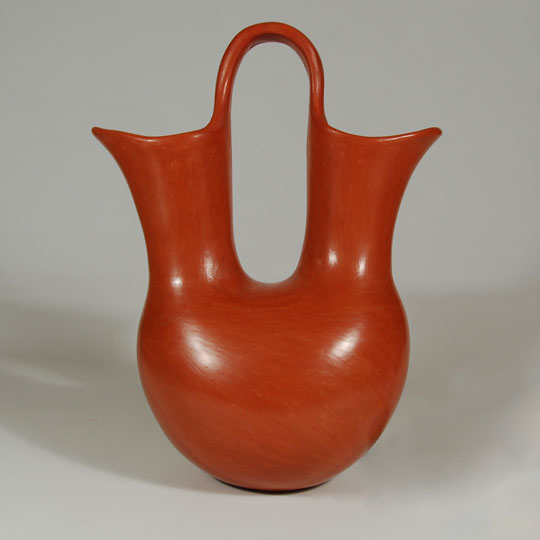 Garnet Pavatea's Hopi name translates in English to Flower Girl. She was a Hopi-Tewa from the Tewa Village on First Mesa. Her dad, Dewakuku, was Hopi and her mother was Tewa. Following tradition, Garnet was of her mother's clan.
Garnet Pavatea's Hopi name translates in English to Flower Girl. She was a Hopi-Tewa from the Tewa Village on First Mesa. Her dad, Dewakuku, was Hopi and her mother was Tewa. Following tradition, Garnet was of her mother's clan.
Hopi artisans owe much to Mary-Russell Ferrell Colton, co-founder with her husband of the Museum of Northern Arizona in Flagstaff. She was instrumental in creating the Hopi Craftsman Exhibition in the early 1930s with the intent of fostering production of quality work. She was concerned that traders were content to accept and sell mediocre work from Hopi craftsmen and were not interested in educating the public on quality crafts. She organized the craft exhibit for the July 4th weekend every year and it has served her intent to greatly increase interest in quality Hopi crafts.
Polychrome Hopi-Tewa Small Pueblo Jar by Rainy Naha - C3803B
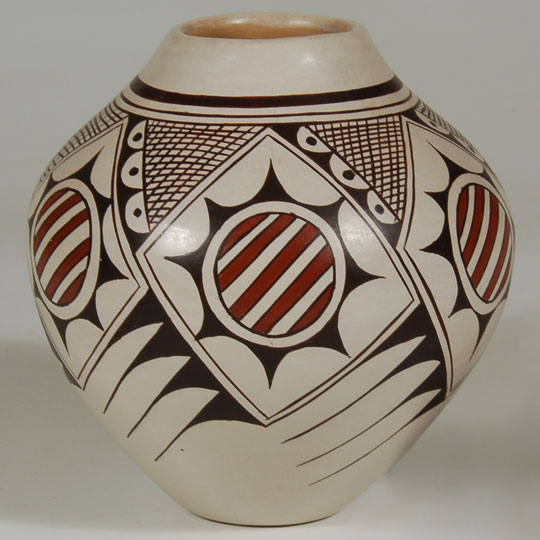 Rainy Naha is a daughter of Helen Naha (1st Feather Woman) and the granddaughter of Paqua Naha (1st Frog Woman). Her siblings are Burel, Sylvia, and Rechenda. She signs her pottery with the traditional feather hallmark used by her mom and then adds the initial R.
Rainy Naha is a daughter of Helen Naha (1st Feather Woman) and the granddaughter of Paqua Naha (1st Frog Woman). Her siblings are Burel, Sylvia, and Rechenda. She signs her pottery with the traditional feather hallmark used by her mom and then adds the initial R.
San Ildefonso Green Slip over Black Lidded Jar by Russell Sanchez - C3800B
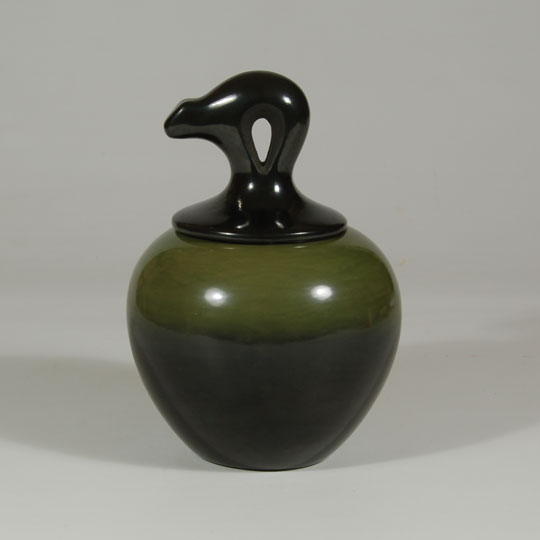 Most collectors of Pueblo pottery are aware of just how talented Russell Sanchez is as an artist. He has been compared to other potters of earlier periods but his work is not like any others. He combines designs and vessel shapes of traditional Tewa Pueblos and enhances those shapes with slips and designs not traditionally used. Russell was one of the early innovators to use green slip as a decorative theme. This jar with green slip is dated 1987, a time when very few potters were experimenting with clays of different colors. Both the lid and jar are signed and dated.
Most collectors of Pueblo pottery are aware of just how talented Russell Sanchez is as an artist. He has been compared to other potters of earlier periods but his work is not like any others. He combines designs and vessel shapes of traditional Tewa Pueblos and enhances those shapes with slips and designs not traditionally used. Russell was one of the early innovators to use green slip as a decorative theme. This jar with green slip is dated 1987, a time when very few potters were experimenting with clays of different colors. Both the lid and jar are signed and dated.
20th Century Acoma Pueblo Jar with Tularosa Design - C3798A
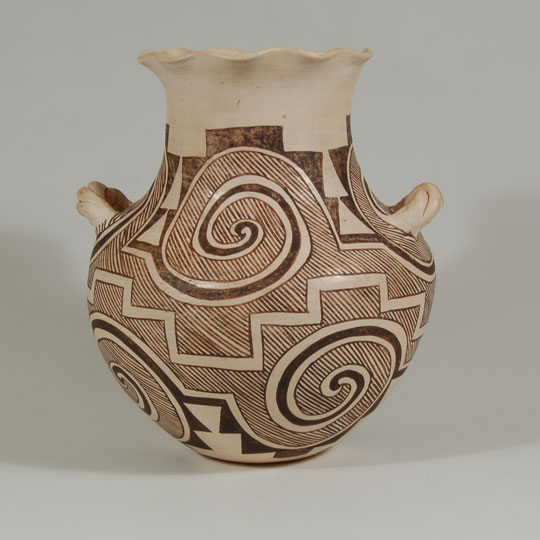 Acoma Pueblo potters have claimed the inherited right to use designs of the earlier Puebloan groups that lived in the early Southwest. The designs of particular striking beauty are those, appropriated by 20th-century Acoma potters, referred to as Tularosa Black-on-white. The Tularosa vessels date from A.D.1100 to 1250. Acoma potters have been particularly involved with the use of these designs since the late 19th century.
Acoma Pueblo potters have claimed the inherited right to use designs of the earlier Puebloan groups that lived in the early Southwest. The designs of particular striking beauty are those, appropriated by 20th-century Acoma potters, referred to as Tularosa Black-on-white. The Tularosa vessels date from A.D.1100 to 1250. Acoma potters have been particularly involved with the use of these designs since the late 19th century.

